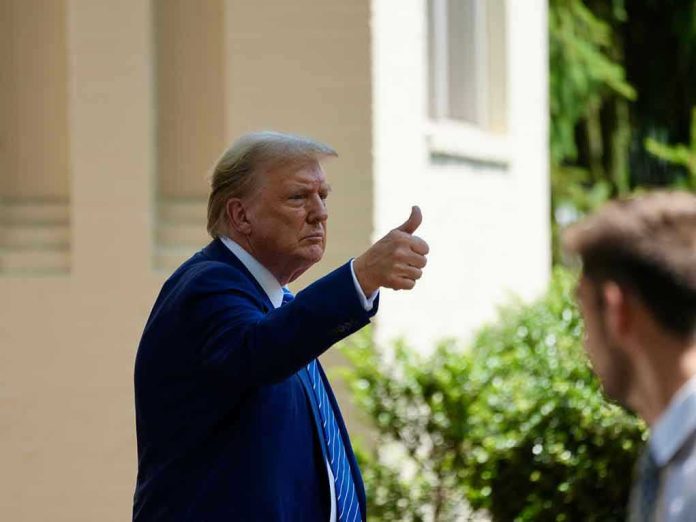
The future of the White House is now a political battleground, as President Trump’s donor-funded ballroom faces threats of demolition if Democrats regain power—turning a symbol of American tradition into the latest casualty of partisan overreach.
Story Snapshot
- The historic East Wing was demolished in late 2025 to make way for a privately funded, 90,000-square-foot Trump-backed ballroom.
- The project bypassed federal appropriations and traditional oversight, igniting fierce debate over constitutional process and preservation.
- With the 2026 election looming, Democrats vow to halt or reverse the construction if they reclaim the White House.
- Many Americans see the controversy as a flashpoint in the ongoing struggle between preserving national heritage and unchecked political agendas.
Demolition of the East Wing: A Historic First Fueled by Private Dollars
In October 2025, the Trump administration made headlines by initiating the first major White House demolition since the Truman era, clearing the historic East Wing to construct a massive new ballroom. Unlike previous renovations, this $200–$300 million project is entirely funded by private donors, many with strong political ties to President Trump.
By sidestepping federal appropriations, the plan has sparked outrage among critics who argue it undermines established oversight and threatens the integrity of America’s most iconic residence.
Supporters of the initiative, including Trump’s core donors and allies, argue the new ballroom is long overdue. For decades, the White House has struggled to accommodate large state events, with the East Room’s limited capacity falling short for modern diplomatic needs.
The new space, designed to hold nearly 1,000 guests, is touted as a practical upgrade that will enhance the nation’s ability to host major gatherings and global summits. Trump’s backers see the project as both a legacy move and a necessary improvement, accomplished without burdening taxpayers.
Partisan Clash: Democrats Threaten to Undo Trump’s Vision
The ballroom’s construction has become a lightning rod in the intensifying partisan divide. Democratic leaders and preservationists have decried the demolition as an “unprecedented” attack on historic architecture, accusing the Trump administration of rushing the project with minimal public input.
With the 2026 presidential election approaching, speculation is rampant that a Democratic victory could lead to the project being halted, redesigned, or outright reversed—potentially wasting millions in donor funds and leaving the White House in a state of limbo.
This uncertainty has fueled public disapproval and raised broader concerns about the politicization of America’s landmarks.
Behind the scenes, watchdogs warn that the administration’s use of regulatory loopholes and rapid timeline may have circumvented meaningful review. While federal agencies like the National Capital Planning Commission have oversight on construction, they had no authority over the demolition itself.
This has left many questioning whether such sweeping changes should be possible without fuller constitutional and public scrutiny, setting a potentially dangerous precedent for future administrations willing to bypass traditional checks and balances.
Impact on National Heritage and American Values
The loss of the East Wing represents more than just a change in floor plans—it strikes at the heart of national heritage and the symbolism embedded in the White House. Preservationists and historians warn that erasing a century-old structure not only alters the physical landscape but risks eroding the shared cultural memory of the American people.
For many conservatives, the controversy highlights a deeper issue: the willingness of political opponents to erase the past and undermine the foundations of American identity in pursuit of their own agendas.
The potential for the project to be reversed or left unfinished if Democrats regain the presidency underscores a troubling trend of government overreach and instability. Instead of respecting the traditions and practical needs of the nation, critics say, partisan actors are increasingly willing to weaponize federal landmarks for short-term political gain.
This clash over the White House ballroom is a stark reminder of the ongoing battle to defend constitutional processes, private initiative, and the enduring values that have long defined the American experiment.
As the 2026 election approaches, the fate of the White House—and the principles it represents—hangs in the balance. The ballroom dispute is not just about bricks and mortar; it is about who gets to shape America’s legacy, and whether the nation will stand firm against efforts to rewrite its story for political convenience.
Conservatives see in this fight a rallying cry to protect what makes America exceptional: respect for history, limited government, and the freedom to build for the future without fear of partisan sabotage.
Sources:
New photos: White House East Wing demolition for Trump ballroom
White House State Ballroom – Wikipedia
The White House announces ballroom construction to begin
New images show White House East Wing leveled
Statement on the Proposed Ballroom Addition at the White House







